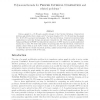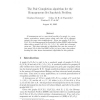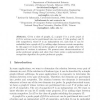1952 search results - page 24 / 391 » Complete partitions of graphs |
CORR
2011
Springer
12 years 11 months ago
2011
Springer
Given a graph G = (V, E) and a positive integer k, the Proper Interval Completion problem asks whether there exists a set F of at most k pairs of (V × V ) \ E such that the graph...
DM
2010
13 years 8 months ago
2010
A labeling of a graph G is distinguishing if it is only preserved by the trivial automorphism of G. The distinguishing chromatic number of G is the smallest integer k such that G ...
CPC
2004
13 years 7 months ago
2004
Mader asked whether every C4-free graph G contains a subdivision of a complete graph whose order is at least linear in the average degree of G. We show that there is a subdivision...
IPL
2006
13 years 7 months ago
2006
A homogeneous set is a non-trivial module of a graph, i.e. a nonempty, non-unitary, proper vertex subset such that all its elements present the same outer neighborhood. Given two ...
COCOON
2008
Springer
13 years 9 months ago
2008
Springer
Given a class of graphs, G, a graph G is a probe graph of G if its vertices can be partitioned into two sets, P (the probes) and N (the nonprobes), where N is an independent set, s...



